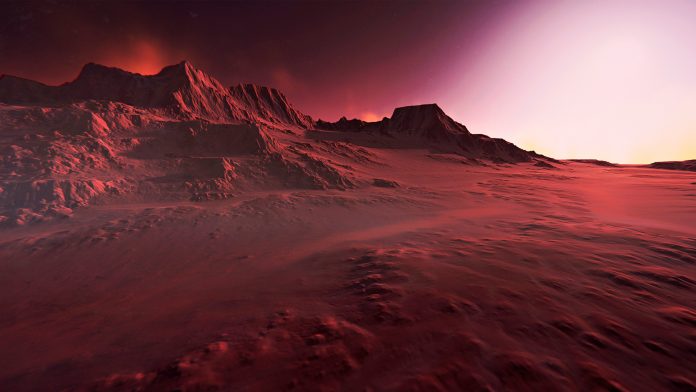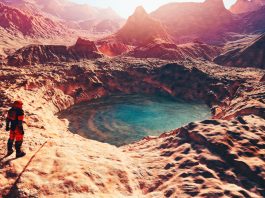Scientists previously discovered what was believed to be liquid water under Mars’ ice-covered South Pole, however a new study has revealed it is most likely a dusty mirage.
How did liquid water on Mars become a dusty mirage?
In 2018, when researchers originally thought they had discovered liquid water on Mars, it was revealed they were observing bight radar reflections under the polar cap.
However, a new study published in the AGU journal Geographical Research Letters discovered that the reflections matched those of volcanic plains found all over Mars’ surface; the journal has collected and published high-impact reports with immediate implications spanning all Earth and space sciences.
Thus, scientists believe that the conclusion of volcanic rock buried under ice is much more plausible than the original assumption of liquid water proposed in 2018.
This initial presumption was already under controversy, as scientists could not understand how water could be kept in a liquid state, due to the cold conditions at Mars’ South Pole.
“For water to be sustained this close to the surface, you need both a very salty environment and a strong, locally generated heat source, but that does not match what we know of this region,” explained Cyril Grima, lead author, and a planetary scientist at The University of Texas at Austin Jackson School of Geosciences.
What did further investigation into the South Pole reveal?
Scientists found that the South Polar mirage dissolved as Grima added an imaginary global ice sheet across a radar map of Mars; the imaginary ice portrayed how Mars’ terrains would appear when observed through a mile of ice. This allowed scientists to make a comparison between features amassing the entire planet, with those under the ice cap.
Through these comparisons, Grima and her team noticed bright reflections; similar to those observed in the South Pole but scattered across all latitudes. Researchers were also able to match the location of volcanic plains in instances where their presence could be confirmed.
On Earth, iron-rich lava flows have the potential to leave behind rocks that reflect radar in a similar way. Other possibilities include mineral deposits in dried riverbeds. Grima commented: “Figuring out what they are could answer important questions about Mars’ history.”
Although, scientists noted that while there may not be liquid water trapped under the Southern polar cap, there is plenty of water ice on Mars, including in the thick polar caps, the new study hints at Mars’ wetter past.
Isaac Smith, a Mars geophysicist at York University, believes the bright radar signatures are a kind of clay made when rock erodes in water. In 2021, Smith, found upon investigation that Earth-based clays reflected radar brightly, just like the bright spots in the 2018 South Pole study, which supports the researchers’ belief that the original findings did not reveal liquid water on Mars.
Smith added: “I think the beauty of Grima’s findings is that while it knocks down the idea there might be liquid water under the planet’s South Pole today, it also gives us really precise places to go look for evidence of ancient lakes and riverbeds and test hypotheses about the wider drying out of Mars’ climate over billions of years.
“Science is not fool proof on the first try. That is especially true in planetary science where we are looking at places no one has ever visited and relying on instruments that sense everything remotely.”
How do scientists plan to further investigate?
The map Grima constructed was based on three years of data collected by the Mars Advanced Radar for Subsurface and Ionosphere Sounding (MARSIS) that was launched in 2005 aboard the European Space Agency’s Mars Express. Researchers intend to investigate this data even further, to discover what else MARSIS can reveal about the planet.
Grima and her team are currently working on proposed missions to find liquid water on Mars with radar, both as a resource for human landing sites, and to search for signs of past life.









